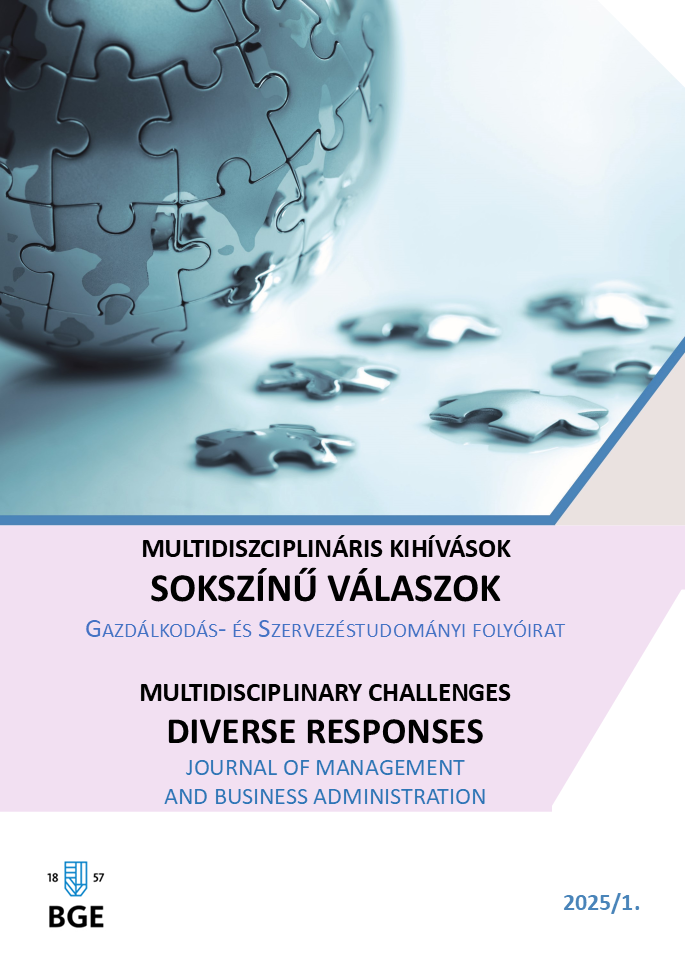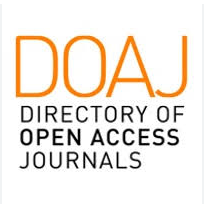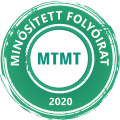Az utolsó védelmi vonal
Információbiztonság-tudatosság a digitális szervezetek korában
Absztrakt
A digitális fenyegetések folyamatos térnyerése új kihívások elé állítja a gazdasági szervezeteket, miközben egyre nyilvánvalóbbá válik, hogy az információbiztonság nem kizárólag technológiai, hanem humán és szervezeti kérdés is. A tanulmány középpontjában a magyar munkavállalók információbiztonság-tudatosságának vizsgálata áll, különös tekintettel arra, hogy milyen tényezők befolyásolják a biztonságtudatos magatartást.
A kutatás empirikus alapját egy kérdőíves adatfelvétel képezte, amely során 525 fő válaszai kerültek elemzésre statisztikai módszerekkel. A válaszadók tudatossági szintje életkor, iskolai végzettség és munkahelyi környezet alapján került megállapításra.
Az eredmények rámutatnak arra, hogy az információbiztonság-tudatosság szintje jelentős eltéréseket mutat az egyes társadalmi és szervezeti csoportok között. A válaszadók egy része alacsony védekezőképességet tanúsít a leggyakoribb fenyegetésekkel szemben, míg mások már integráltan alkalmazzák a biztonságtudatos magatartás alapelveit. A vállalati méret, a szervezeti kultúra, valamint az oktatás és képzés rendszere kiemelkedő hatással bír a tudatosság kialakulására.
A tanulmány arra hívja fel a figyelmet, hogy a kiberbiztonság nem pusztán technikai kérdés: a jövő védelme az emberekben, nem pedig kizárólag az algoritmusokban rejlik – különösen egy olyan korszakban, ahol a mesterséges intelligencia térnyerése az információbiztonság etikai, jogi és társadalmi dimenzióit is új szintre emeli.
Hivatkozások
2013. évi L. törvény az állami és önkormányzati szervek elektronikus információ-biztonságáról. (2013). https://mkogy.jogtar.hu/jogszabaly?docid=a1300050.TV
2024. évi LXIX. törvény Magyarország kiberbiztonságáról. (2024). https://mkogy.jogtar.hu/jogszabaly?docid=A2400069.TV
Ackoff, R. (1989). From Data to Wisdom. Journal of Applied Systems Analysis, 16, 3-9. University of Lancaster.
Alboqami, H. (2023). Factors Affecting Consumers Adoption of AI-Based Chatbots: The Role of Anthropomorphism. American Journal of Industrial and Business Management, 13(4), 195. https://doi.org/10.4236/ajibm.2023.134014
Al-Zahrani, A. M. (2024). Unveiling the shadows: Beyond the hype of AI in education. Heliyon, 10(9). https://doi.org/10.1016/j.heliyon.2024.e30696
Calvano, M., Curci, A., Desolda, G., Esposito, A., Lanzilotti, R., & Piccinno, A. (2025). Building Symbiotic AI: Reviewing the AI Act for a Human-Centred, Principle-Based Framework. https://doi.org/10.48550/ARXIV.2501.08046
Christen, M., Blumer, H., Hauser, C., & Huppenbauer, M. (2019). The Ethics of Big Data Applications in the Consumer Sector. In Springer eBooks (p. 161). Springer Nature. https://doi.org/10.1007/978-3-030-11821-1_10
Copeland, B. J (szerk.) (2004): The Essential Turing Seminal Writingsin Compu-ting, Logic, Philosophy, Artificial Intelligence, and Artificial Life plus The Secrets of Enigma. Oxford University Press
Cordero, J., Barba-Guamán, L., & Guamán, F. (2022). Use of chatbots for customer service in MSMEs. Applied Computing and Informatics. https://doi.org/10.1108/aci-06-2022-0148
Cox, S. R., Lee, Y., & Ooi, W. T. (2023). Comparing How a Chatbot References User Utterances from Previous Chatting Sessions: An Investigation of Users’ Privacy Concerns and Perceptions. 105. https://doi.org/10.1145/3623809.3623875
Darwin, V., & Nkongolo, M. (2023). Data Protection for Data Privacy-A South African Problem? arXiv (Cornell University). https://doi.org/10.48550/arxiv.2306.09934
Davenport, T. H., & Prusak, L. (2001). Tudásmenedzsment. Kossuth Kiadó
Digital Economy and Society Index (DESI). (2022) Európai Bizottság. https://digital-strategy.ec.europa.eu/hu/library/digital-economy-and-society-index-desi-2022 (utolsó hozzáférés: 2025.06.30.)
Drljača, D., & Latinović, B. (2017). Audit in public administration’s information systems – External or internal? IOP Conference Series Materials Science and Engineering, 200, 12026. https://doi.org/10.1088/1757-899x/200/1/012026
Gémes Cs. (2017. december). Az információbiztonság alapkérdései, Hadmérnök, 12(4), 128-137.
Guan, H., Dong, L., & Zhao, A. (2022). Ethical Risk Factors and Mechanisms in Artificial Intelligence Decision Making. Behavioral Sciences, 12(9), 343. https://doi.org/10.3390/bs12090343
Hand, D. J. (2018). Aspects of Data Ethics in a Changing World: Where Are We Now? [Review of Aspects of Data Ethics in a Changing World: Where Are We Now?]. Big Data, 6(3), 176. Mary Ann Liebert, Inc. https://doi.org/10.1089/big.2018.0083
Helbing, D. (2013). From Technology-Driven Society to Socially Oriented Technology. The Future of Information Society -- Alternatives to Surveillance. arXiv (Cornell University). https://doi.org/10.48550/arxiv.1307.2397
Hermann, E. (2021). Leveraging Artificial Intelligence in Marketing for Social Good—An Ethical Perspective. Journal of Business Ethics, 179(1), 43. https://doi.org/10.1007/s10551-021-04843-y
Hernández, E. (2024). Towards an Ethical and Inclusive Implementation of Artificial Intelligence in Organizations: A Multidimensional Framework. arXiv (Cornell University). https://doi.org/10.48550/arxiv.2405.01697
Huang, L. (2023). Ethics of Artificial Intelligence in Education: Student Privacy and Data Protection. Science Insights Education Frontiers, 16(2), 2577. https://doi.org/10.15354/sief.23.re202
Huang, M., & Rust, R. T. (2020). A strategic framework for artificial intelligence in marketing. Journal of the Academy of Marketing Science, 49(1), 30. https://doi.org/10.1007/s11747-020-00749-9
Illésy M., Nemeslaki A., & Som Z. (2014). Elektronikus információbiztonság tudatosság a magyar közigazgatásban. Információs Társadalom, XIV, 1. szám. 52-73.
ISACA. (2013). ISACA magyar szakkifejezés-gyűjtemény.
Jacobs J., Haney J., & Furman S. (2022). Measuring the Effectiveness of U.S. Government Security Awareness Programs: A Mixed-Methods Study (Short Paper). Eighteenth Symposium on Usable Privacy and Security (SOUPS 2022) 8th Workshop on Security Information Workers (WSIW 2022).
Koltay T. (2008. augusztus). A bölcsesség hierarchiája: az adat-, információ-, tudás-, bölcsességhierarchia reprezentációi, Tudományos és Műszaki Tájékoztatás, 55(8), 2008.
Kovács L., & Krasznay Cs. (2010). Digitális Mohács. Nemzet és biztonság, 3., 44-56.
Kruger, H. A., & Kearney, W. D. (2006). A prototype for assessing information security awareness. Computer & Security, 25, 289-296, Elsevier BV. https://doi.org/10.1016/j.cose.2006.02.008
Kubaisi, A. A. S. H. A. (2024). Ethics of Artificial Intelligence a Purposeful and Foundational Study in Light of the Sunnah of Prophet Muhammad. Religions, 15(11), 1300. https://doi.org/10.3390/rel15111300
Larsson, S. (2018). Algorithmic governance and the need for consumer empowerment in data-driven markets. Internet Policy Review, 7(2). https://doi.org/10.14763/2018.2.791
Latham, A., & Goltz, N. (2019). A Survey of the General Public’s Views on the Ethics of Using AI in Education. In Lecture notes in computer science (p. 194). Springer Science+Business Media. https://doi.org/10.1007/978-3-030-23204-7_17
Lee, R.-W., Choi, S.-H., & Hu, S.-H. (2023). Effect of temporal distance and goal type on predictions of future information security: Focus on moderation of self-efficacy and social responsibility. Acta Psychologica, 238. Elsevier BV. https://doi.org/10.1016/j.actpsy.2023.103990
Liu, F. (2020). A Statistical Overview on Data Privacy. arXiv (Cornell University). https://doi.org/10.48550/arxiv.2007.00765
Lou, C., Kang, H., & Tse, C. H. (2021). Bots vs. humans: how schema congruity, contingency-based interactivity, and sympathy influence consumer perceptions and patronage intentions. International Journal of Advertising, 41(4), 655. https://doi.org/10.1080/02650487.2021.1951510
Métayer, D. L., Danezis, G., Hansen, M., Hoepman, J.-H., Tirtea, R., Schiffner, S., & Domingo‐Ferrer, J. (2015). Privacy and Data Protection by Design - from policy to engineering. arXiv (Cornell University). https://doi.org/10.48550/arxiv.1501.03726
Mitnick, K.D., & Simon, W. L. (2003). The Art of Deception: Controlling the Human Element of Security. Wiley Publishing.
Muha L. (2008). Az informatikai biztonság egy lehetséges rendszertana. Bolyai szemle, 17(4), 137-156.
Munk S. (2008). Információbiztonság vs. informatikai biztonság. Hadmérnök, 1-21.
Naik, N., Hameed, B. M. Z., Shetty, D. K., Swain, D., Shah, M., Paul, R., Aggarwal, K., Ibrahim, S., Patil, V., Smriti, K., Shetty, S., Prasad, B., Chłosta, P., & Somani, B. (2022). Legal and Ethical Consideration in Artificial Intelligence in Healthcare: Who Takes Responsibility? [Review of Legal and Ethical Consideration in Artificial Intelligence in Healthcare: Who Takes Responsibility?]. Frontiers in Surgery, 9. Frontiers Media. https://doi.org/10.3389/fsurg.2022.862322
Nazarov, А., Nazarov, D., & Kovtun D. (2021). Information security of territorial stability. E3S Web of Conferences, 291, 3018. https://doi.org/10.1051/e3sconf/202129103018
Olorunfemi, O. L., Amoo, O. O., Atadoga, A., Fayayola, O. A., Abrahams, T. O., & Shoetan, P. O. (2024). Towards A Conceptual Framework For Ethical Ai Development In It Systems. Computer Science & IT Research Journal, 5(3), 616. https://doi.org/10.51594/csitrj.v5i3.910
Pereira, F., Correia, R., Pinho, P., Lopes, S. I., & Carvalho, N. B. (2020). Challenges in Resource-Constrained IoT Devices: Energy and Communication as Critical Success Factors for Future IoT Deployment [Review of Challenges in Resource-Constrained IoT Devices: Energy and Communication as Critical Success Factors for Future IoT Deployment]. Sensors, 20(22), 6420. Multidisciplinary Digital Publishing Institute. https://doi.org/10.3390/s20226420
Pusztahelyi, R. (2021). Towards a European AI liability system. Multidiszciplináris Tudományok, 11(5), 317. https://doi.org/10.35925/j.multi.2021.5.35
Radziwill, N., & Benton, M. C. (2017). Evaluating Quality of Chatbots and Intelligent Conversational Agents. arXiv (Cornell University). https://doi.org/10.48550/arxiv.1704.04579
Rooy, D. V., & Bus, J. C. P. (2010). Trust and privacy in the future internet—a research perspective. Identity in the Information Society, 3(2), 397. https://doi.org/10.1007/s12394-010-0058-7
Rowley, J. (2007). The wisdom hierarchy: representations of the DIKW hierarchy. Journal of Information Science, 33 (2), 163-180.
SANS (2023). Security Awareness Report, Managing Human Risk., [Éves jelentés].
Schaik, P. van, Jeske, D., Onibokun, J., Coventry, L., Jansen, J., & Kusev, P. (2017). Risk perceptions of cyber-security and precautionary behaviour. Computers in Human Behavior, 75, 547. https://doi.org/10.1016/j.chb.2017.05.038
Schlienger, T., & Teufel S. (2003). Information security culture - From analysis to change. South African Computer Journal, 46–52
Shehu, V. P., & Shehu, V. (2023). Human rights in the technology era – Protection of data rights. Deleted Journal, 7(2), 1. https://doi.org/10.2478/ejels-2023-0001
T.S. Eliot, The Rock (Faber & Faber, London, 1934)
Tarján G. (2020). Az információbiztonsági tudatosság érettségi szintjének mérése szervezetekben [Doktori értekezés]. Budapesti Corvinus Egyetem
Vágány P. (2023). A leggyengébb láncszem vagy az utolsó védvonal? – Informá-cióbiztonság tudatosság gazdálkodó szervezeteknél, METU, 2023 (diplomadolgozat)
Vágány, P. (2024). Ne legyen áldozat! Néhány gondolat az információbiztonságról. Mezőgazdasági Technika, 2024 április, pp 38-40
Weydner-Volkmann, S. (2023). Using Open, Public Data for Security Provision: Ethical Perspectives on Risk-Based Border Checks in the EU. European Journal for Security Research, 8, 25. https://doi.org/10.1007/s41125-023-00092-4
Wilson, M., & Hash, J. (2003). Building an Information Technology Security Awareness and Training Program. National Institute of Standards and Technology. https://doi.org/10.6028/nist.sp.800-50
Zeleny, M. (1987). Management support systems: Towards integrated knowledge management, Human Systems Management, 7(1), 59–70.


























